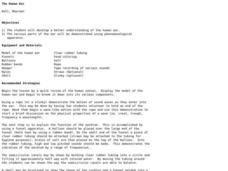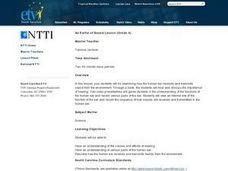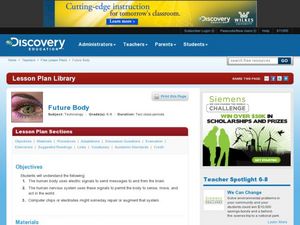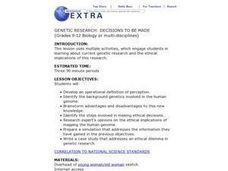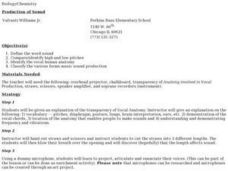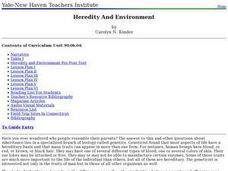Curated OER
The Human Ear
Students explore the human ear. In this biology lesson plan, students develop a better understanding of the various parts of the human ear as they explore a hands-on apparatus.
Nuffield Foundation
Assessing Human Hearing
Young scientists explore hearing through multiple experiments, demonstrations, and activities. They focus on the changes in hearing over a lifetime, how we can determine where a sound is coming from, and the ability to filter noises.
Curated OER
An Earful of Sound Lesson
Fourth graders examine how the human ear receives and transmits sound from the environment. Through a book, they hear and discuss the importance of hearing. Students view an Internet site of the function of the ear and record the...
Curated OER
Family Traits
Students investigate the study of pedigree designs and human genetics. They construct the pedigree representing two, three, or four generations. They investigate their family members' traits for ear lobe attachment, tongue rolling,...
Curated OER
Making Sense of Things: The Human Body and Senses
Students conduct an experiment to evaluate the accuracy of their senses.
Curated OER
Beautiful Bovine
Looking for a fun and interactive way to explore bovine biology? Learners read a brief informational text (included for printing) before participating in several cross-curricular activities. First, grab their attention with a hilarious...
Curated OER
Future Body
Students explain the benefits of cyborg augmentation. In this technology lesson, students research how the nervous system works. They create posters and present them to class.
Curated OER
Genetic Research: Decisions to be Made
Learners examine the genetics involved in the human genome. They brainstorm the advantages and disadvantages to this discovery. They research different experts opinion and write a case study which addresses an ethical dilemma.
Curated OER
Recovering the Romanovs
Students use DNA to solve an identity mystery. In this biology instructional activity, students use the Internet to gather information about sex-linked disorders and complete a Punnett square for hemophilia, then examine a handwriting...
Curated OER
Vocal Exploration
Students explore vocal anatomy. In this biology/music lesson, students first learn vocabulary associated with the voice and body. They then use straws, microphones and recorders to differentiate between high and low pitches and...
Curated OER
Plants of the Past
Fourth graders explore ecosystems by examining plants of the past. They discuss ways in which we interact with plants in our daily lives. Students discuss the role plants play in providing food for animals and the significance they had...
Curated OER
Antibiotic Resistance
Students using the scientific method, study bacteria as a covering surface of the earth in many forms. They discover that not all bacteria is bad and introduce the topic of antibiotic resistance. Science Fair expectations are addressed.
Curated OER
Heredity And Environment
Students complete a pre-test on the relationship between heredity and the environment. As a class, they write down descriptions of themselves and identify which traits can be changed and not changed. In groups, they determine which genes...
Curated OER
Cranes, Crosswalks, and Big Gulps
Young scholars watch a video and answer questions based on wildlife jobs. In this wildlife lesson plan, students learn that biologists don't just play with animals but that there is a lot of study involved.
Curated OER
Homology: Where Does The Evidence Lead
Learners are introduced to the topic of homology. In groups, they read a case study and compare different drawings of early vertebrate emryos. They work together to answer discussion questions and label the various parts of each embryo.


